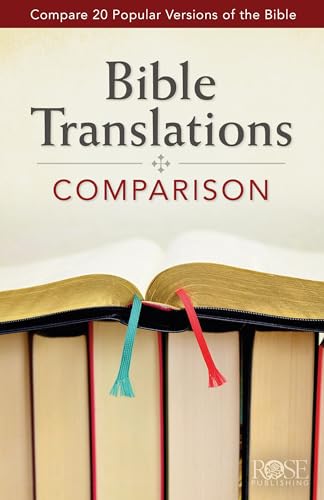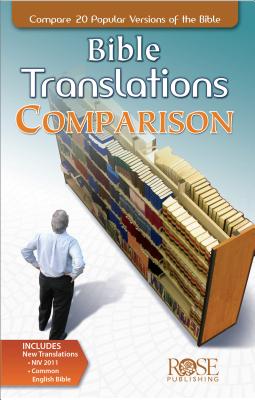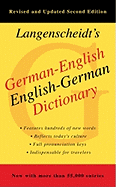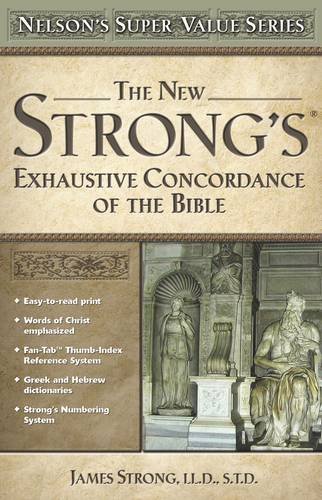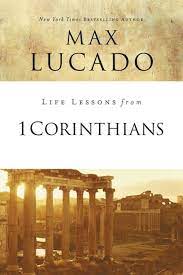Bible Translations Comparison pamphlet
$6.99
Key Features
Scholars have been translating the Bible for 2000 years and over the centuries, three primary methods of translation have evolved. The Bible Translations Comparison chart helps pastors, teachers, and students of the Word understand the approach to 20 Bible translations by providing the following information: Translation method & reading level; Year it was published; Number of translators who worked on the project; Sponsor of the translation version; Textual basis; Purpose; Noteworthy facts; Sample verses. This Bible Translations Comparison fold-out chart also provides a brief glossary of key words regarding translations, as well as a diagram that explains the three most popular Greek texts used for Bible translation. The Bible Translations pamphlet compares the following Bible translations: American Standard Version (ASV); Amplified Bible (AMP); New American Standard Bible (NASB); Revised Standard Version (RSV); New Revised Standard Version (NSRV); English Standard Version (ESV); King James Version (KJV); New King James Version (NKJV); New Jerusalem Bible (NJB); New American Bible (NAB); New International Version (NIV); Today’s New International Version (TNIV); God’s Word (GW); Holman Christian Standard Bible (HCSB); New Century Version (NCV); New Living Translation (NLT); New International Readers Version (NIrV); Good News Translation (GNT); Contemporary English Version (CEV); The Message. The pamphlet’s introductory information explains why new translations continue to appear. Also provided is a brief overview of the three primary methods of translation as well as a fourth translation treatment that has evolved over the centuries. The side-by-side translations are color coded to reference the four translation treatments shown below: 1. Word-for-Word 2. Balance—a process that mediates between word-for-word and thought-for-thought 3. Thought-for-thought 4. Paraphrase—a restatement of a translation. The Bible Translations Comparison pamphlet provides a list of 13 “Important Words to Know” such as: Apocrypha, Biblia Hebraica, Dead Sea Scrolls, Masoretic Text, Septuagint. And the major groups of Greek manuscripts, or text types: Western, Lucianic, Byzantine, Alexandrian
Ways to get your order
Free Pickup Available
122 Church St W. Elmira
In Stock items are usually ready in 24 hours
0 In Stock
Delivery
Most orders shipped within 24 hours.
Shipping calculated at Checkout
Also Find It in Store:
Row: 9, Unit: C, Shelf: 2
ASK A QUESTIONScholars have been translating the Bible for 2000 years and over the centuries, three primary methods of translation have evolved. The Bible Translations Comparison chart helps pastors, teachers, and students of the Word understand the approach to 20 Bible translations by providing the following information: Translation method & reading level; Year it was published; Number of translators who worked on the project; Sponsor of the translation version; Textual basis; Purpose; Noteworthy facts; Sample verses. This Bible Translations Comparison fold-out chart also provides a brief glossary of key words regarding translations, as well as a diagram that explains the three most popular Greek texts used for Bible translation. The Bible Translations pamphlet compares the following Bible translations: American Standard Version (ASV); Amplified Bible (AMP); New American Standard Bible (NASB); Revised Standard Version (RSV); New Revised Standard Version (NSRV); English Standard Version (ESV); King James Version (KJV); New King James Version (NKJV); New Jerusalem Bible (NJB); New American Bible (NAB); New International Version (NIV); Today’s New International Version (TNIV); God’s Word (GW); Holman Christian Standard Bible (HCSB); New Century Version (NCV); New Living Translation (NLT); New International Readers Version (NIrV); Good News Translation (GNT); Contemporary English Version (CEV); The Message. The pamphlet’s introductory information explains why new translations continue to appear. Also provided is a brief overview of the three primary methods of translation as well as a fourth translation treatment that has evolved over the centuries. The side-by-side translations are color coded to reference the four translation treatments shown below: 1. Word-for-Word 2. Balance—a process that mediates between word-for-word and thought-for-thought 3. Thought-for-thought 4. Paraphrase—a restatement of a translation. The Bible Translations Comparison pamphlet provides a list of 13 “Important Words to Know” such as: Apocrypha, Biblia Hebraica, Dead Sea Scrolls, Masoretic Text, Septuagint. And the major groups of Greek manuscripts, or text types: Western, Lucianic, Byzantine, Alexandrian
Additional information
| Weight | 0.05 lbs |
|---|---|
| Dimensions | 5.5 × 0.1 × 8.6 in |
| Brand |
Customer Reviews
| 5 star | 0% | |
| 4 star | 0% | |
| 3 star | 0% | |
| 2 star | 0% | |
| 1 star | 0% |
Sorry, no reviews match your current selections
Bible Translations Comparison pamphlet
$6.99
Out of Stock
Scholars have been translating the Bible for 2000 years and over the centuries, three primary methods of translation have evolved. The Bible Translations Comparison chart helps pastors, teachers, and students of the Word understand the approach to 20 Bible translations by providing the following information: Translation method & reading level; Year it was published; Number of translators who worked on the project; Sponsor of the translation version; Textual basis; Purpose; Noteworthy facts; Sample verses. This Bible Translations Comparison fold-out chart also provides a brief glossary of key words regarding translations, as well as a diagram that explains the three most popular Greek texts used for Bible translation. The Bible Translations pamphlet compares the following Bible translations: American Standard Version (ASV); Amplified Bible (AMP); New American Standard Bible (NASB); Revised Standard Version (RSV); New Revised Standard Version (NSRV); English Standard Version (ESV); King James Version (KJV); New King James Version (NKJV); New Jerusalem Bible (NJB); New American Bible (NAB); New International Version (NIV); Today’s New International Version (TNIV); God’s Word (GW); Holman Christian Standard Bible (HCSB); New Century Version (NCV); New Living Translation (NLT); New International Readers Version (NIrV); Good News Translation (GNT); Contemporary English Version (CEV); The Message. The pamphlet’s introductory information explains why new translations continue to appear. Also provided is a brief overview of the three primary methods of translation as well as a fourth translation treatment that has evolved over the centuries. The side-by-side translations are color coded to reference the four translation treatments shown below: 1. Word-for-Word 2. Balance—a process that mediates between word-for-word and thought-for-thought 3. Thought-for-thought 4. Paraphrase—a restatement of a translation. The Bible Translations Comparison pamphlet provides a list of 13 “Important Words to Know” such as: Apocrypha, Biblia Hebraica, Dead Sea Scrolls, Masoretic Text, Septuagint. And the major groups of Greek manuscripts, or text types: Western, Lucianic, Byzantine, Alexandrian
